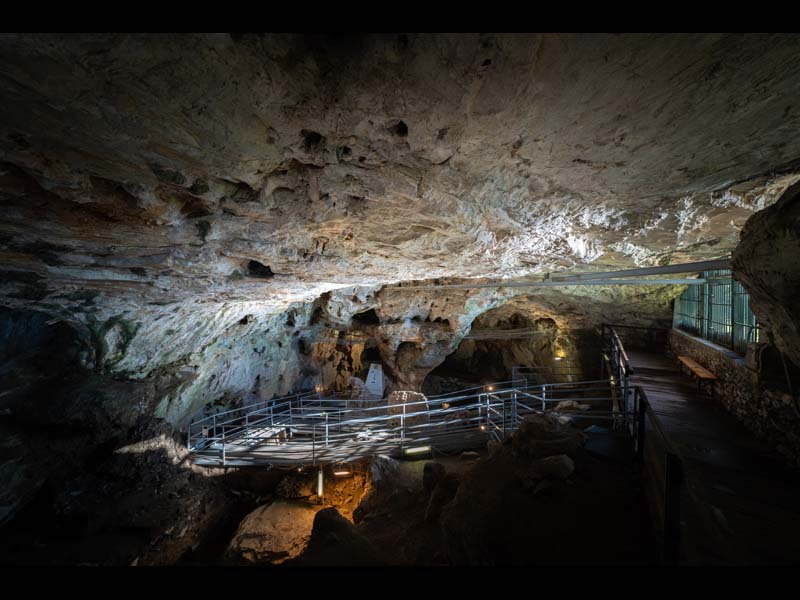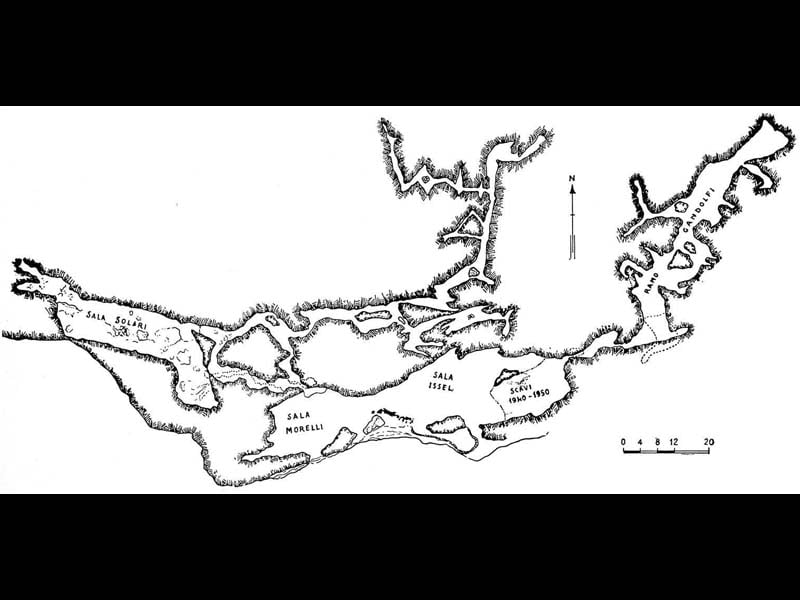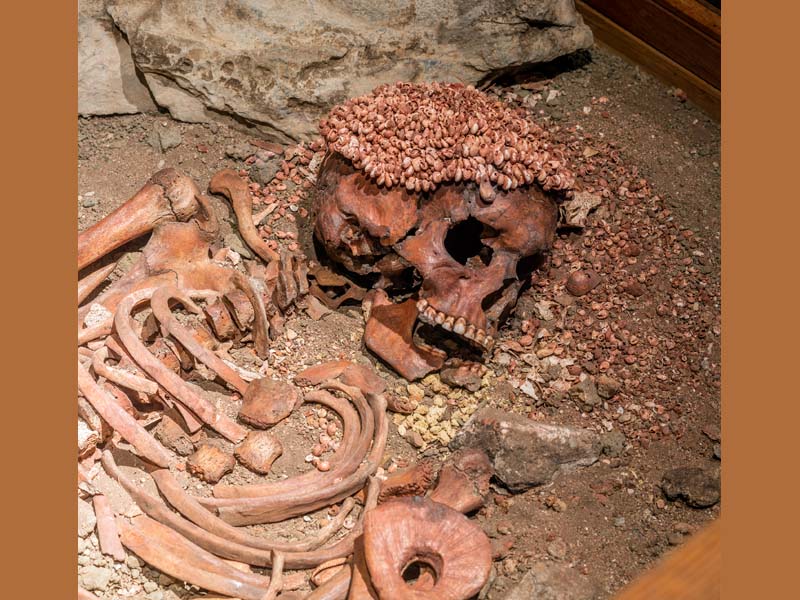di Elvira Visciola under the supervision of Elisa Bianchi, Conservator of the Archaeological Museum of Finale
The Arene Candide Cave is of fundamental international importance as it provides a sequence of about 10 meters of sediments with traces of human occupation between the Upper Paleolithic (about 32.000 BC) and the VI-VII century AD, therefore it appears to be today the most complete and best investigated archaeological stratigraphy of the western Mediterranean. In particular, the cave was used for about 30.000 years with different functions depending on the period, in the Upper Paleolithic as a burial place, during the Neolithic as a dwelling with spaces for sheltering animals and as a burial place (most of the Neolithic burials in the Finale area come from the Arene Candide), in Roman times for production activities and for the conservation of foodstuffs. Furthermore, the stratigraphic deposit documents all the phases of the Neolithic (5.800-3.600 BC, with the oldest dating for the Neolithic of Northern Italy and for the Western Mediterranean referring to 5.800 BC, obtained from a grain of barley trapped inside of the mixture of a ceramic fragment found in the Early Neolithic levels of the cave), all phases of the Metal Age (Copper, Bronze and Iron), up to the Roman and Byzantine levels which close the sequence.
The cave is located about 89 meters above sea level, on the Caprazoppa promontory which separates Finale Ligure Marina from Borgio Verezzi, in the Province of Savona. It takes its name from the white quartz sand dune that the winds of the last glaciation had leaned against the promontory, a dune that is currently almost completely disappeared mainly due to the intense activity of the neighboring quarry of the Ghigliazza brothers, owners of the land, who favored the extraction of the famous "Finale stone" used both as a building material and for glass art; currently only a few residues of the sand remain concretionary on the wall, while the dune appears in some photos from the early 20s, when it extended from the slopes of the cave to the seashore.
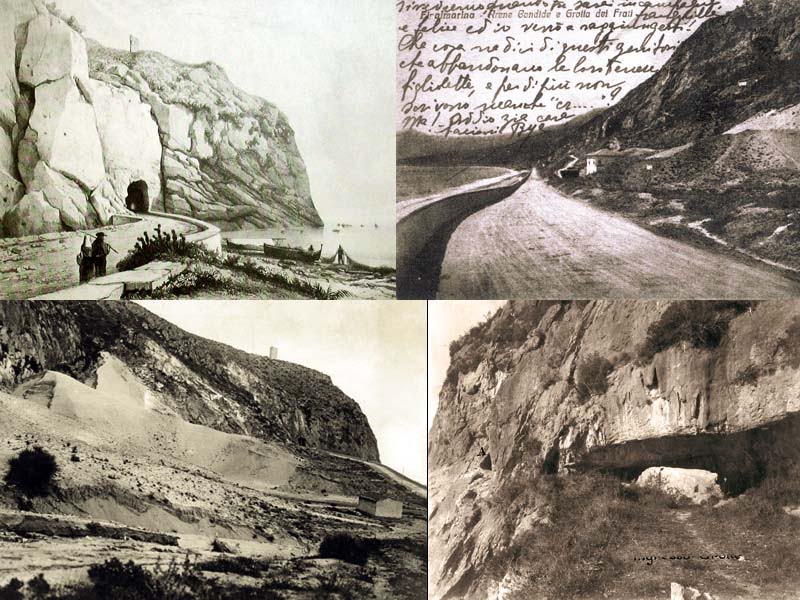
The cavity measures 70 x 20 meters and has an elongated shape in the east-west direction, with the opening divided in two by an enormous boulder, currently welded to the vault by stalagmite concretions. The internal part is divided into 3 zones: the longer and narrower central one is called the "Issel chamber"; the one on the left, the "Morelli room", has a circular shape from which short tunnels branch off, one of which leads to a large room, the "Solari"; the one on the right, the "Gandolfi room", is smaller with the entrance marked by a rocky pillar, full of concretions and stalagmites and is difficult to access.
The explorations of the cave began with the geologist Arturo Issel in June 1864, when he went there for the first time in the company of the naturalist Adolfo Perez of Nice (known in the news because he had already excavated in the Balzi Rossi caves finding precious finds), becoming I soon realized the enormous potential of the site, but about 10 years had to pass before starting the actual research.
In fact, in 1874 Issel, together with the British consul in Genoa, Mr. Yeats Brown Montagne and the zoologist Victor Brooke, started the excavations finding at about 40-50 cm. deep traces of a hearth, crockery shards and at a depth of 160 cm. a human skeleton, a stone hatchet, various pieces of ocher, a child's skeleton, and other artifacts.
In the same year, the priest Don Pietro Perrando also went to the cave twice, bringing to light some parts of a child's skeleton as well as two skeletons, one of which is almost complete, and many artifacts; among the latter, of particular importance is the discovery of the first "light bulb", at about 2 meters below the ground, i.e. a small terracotta vase in the shape of a pipe, a typical Neolithic vase from the caves of the Finale area.
Also in the same year, a new explorer, Anton Giulio Barrili, discovered a fifth skeleton complete with shards and shells.
The succession of these discoveries led the Ministry of Public Education to promote a new excavation campaign, entrusted to Issel who, between 24 August and 3 September 1876, discovered seven new inviolate sepulchres in the eastern and middle part of the cave, some in excellent state, and a rich series of artifacts in terracotta, stone and bone.
In 1883 Alfred John Wall, an English doctor in the East Indies army, attempted new excavations towards the eastern end of the main chamber of the cave, penetrating into a still virgin chamber where he found the remains of a hearth, numerous shards, bones, shells, fragments of crockery, about 70 elements for jewelry in the form of perforated cylinders, some small flint knives, a terracotta lamp as well as five burials; in the same area the priest Nicolò Angelo Andrea Morelli brought to light various artifacts in stone, bone and terracotta.
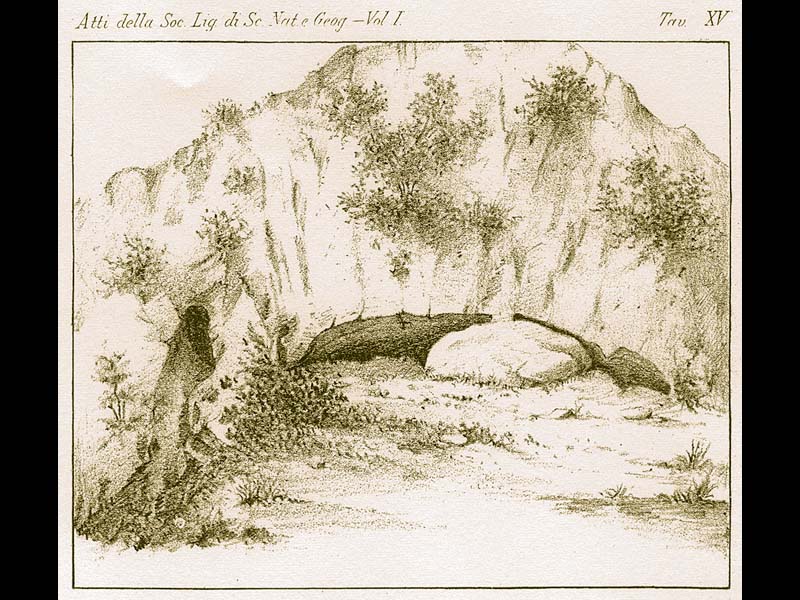
From 1885 to 1888 the excavations were continued by Morelli in various points of the cave neglected by his predecessors, in particular at the western end and towards the north-east, with the discovery of a conspicuous number of Neolithic burials, mainly of children, and the first clay figurine found in Liguria (the statue no. 1). Of particular interest are the watercolor plates produced by Morelli in a manuscript to illustrate and document his discoveries, often the only trace of his findings.
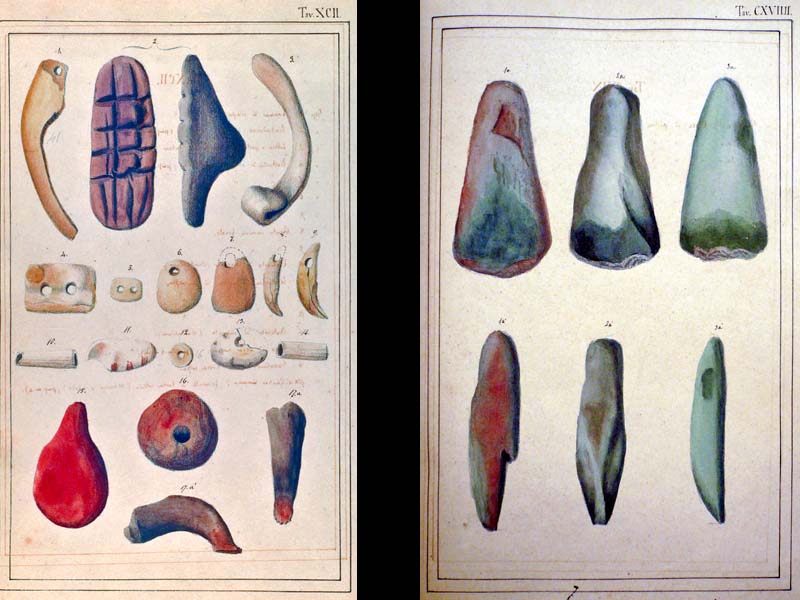
Researches of a certain size were then carried out by Mr. Giovanni Battista Rossi before 1893, but after about thirty years of more or less scientifically conducted excavations these ceased completely; the material collected over the years was mostly preserved in the Civic Museum of Ligurian Archeology of the Villa Durazzo Pallavicini in Genoa Pegli and to a lesser extent in the Luigi Pigorini Prehistoric and Ethnographic Museum in Rome, while there is little news of the numerous clandestine excavations that took place in the cave, reported in the work diaries of all the official researchers, activities mostly intended for finding finds for the antiques market.
On 1939 July 1940, the twenty-nine-year-old Luigi Bernabò Brea was elected archaeologist Superintendent of Liguria, who immediately concentrated on the Finale area with the aim of identifying the archaeological stratigraphy in the caves which until then had been investigated without any scientific rigor. In XNUMX he visited almost all the main caves in the area, including the Arene Candide where he decided to carry out the first systematic excavation in the points where the backfill of the nineteenth-century excavations had been piled up, assuming that these areas below the layers investigated were intact .
With the collaboration of Prof. Luigi Cardini of the Institute of Human Paleontology in Rome, excavations began on 24 October 1940 which continued in successive 4 campaigns until 1942 and made it possible to identify a stratigraphic succession of 28 layers, from the Roman age up to Neolithic and beyond up to the Upper Paleolithic, when the disappearance of domestic animals and imprinted pottery is recorded (from layer 23 to 28).
During the fourth excavation campaign, which took place between 20 March and 22 May 1942, the underlying pre-Neolithic levels were investigated, a campaign that proved to be extremely fruitful because, in addition to the numerous Epigravettian tombs, it was brought to light, exactly on 1 May 1942 , the burial of theYoung Prince” from the Gravettian era, dated to 26.300 BC, with the rich set of ornaments and tools.
The war events led to the interruption of the research which resumed only in April 1948, again under the direction of Bernabò Brea, with 4 other excavation campaigns up to 1950 which, except for the VII aimed largely at the Epigravettian strata, mainly concerned the ceramic deposit. In the last two campaigns Bernabò Brea was unable to participate because he was exiled to Lipari as he had opposed the fascist regime, therefore the VII was directed by Prof. Luigi Cardini, of the Italian Institute of Human Paleontology and the VIII (from 28 April to 26 June 1950) by the archaeologist Virginia Ginetta Chiappella. The materials of these 4 excavation campaigns were then sorted partly in the Civic Museum of Ligurian Archeology of the Villa Durazzo Pallavicini in Genoa Pegli and partly in the Museum of Finale Ligure.

Analyzing the stratigraphy of the site investigated by Bernabò Brea, the following periods are highlighted:
Layer 1: it is the most superficial, stony with fragments of large wine amphorae from the Imperial Roman age and other minor vases in unpainted clay contemporary to them as well as fragments of dark clay vases decorated with grooves made on the lathe, cylindrical soapstone vases and glasses vitreous belonging to the late Roman age, materials that testify to the use of the cave as a warehouse for food and goods.
Layer 2: contains the first impasto pottery, extremely rough, badly smoothed, attributable to the Golasecca culture and dated to the Iron Age, with the first evidence of lithic and bone industry, small knives, various flint flakes, a considerable quantity of pierced shells (certainly used for jewelery and necklaces) and a piece of limonitic yellow ochre. In the same layer traces of hearths were found with holes around them where it is hypothesized poles were planted that supported the spits on which the meat was roasted.
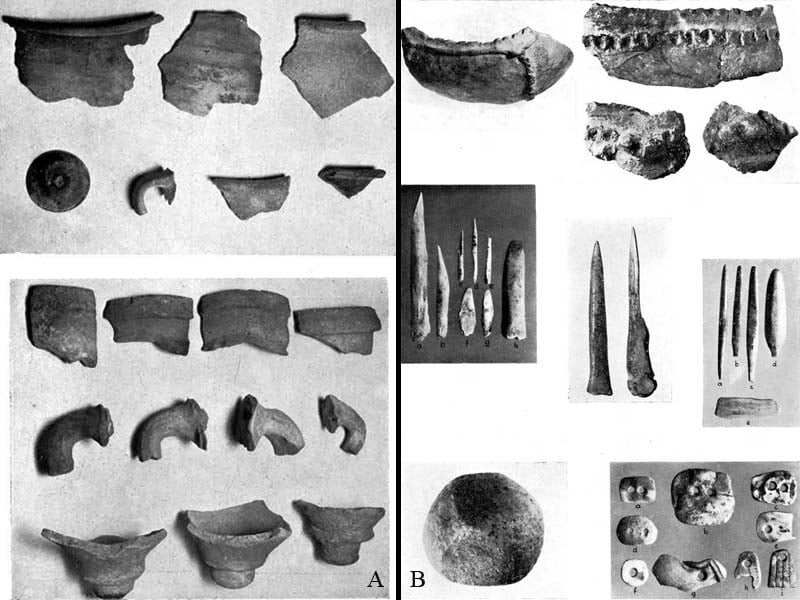
Layers 3 to 8: they are layers poor in archaeological material, with very rough impasto pottery in the more superficial layers up to a finer, shiny and well-polished pottery in the colors black and red coral starting from layer 5; in any case there are few significant pieces, with ax handles and furrow decorations from the Bronze Age.
Layers 9 to 13: layers in which pottery is more abundant, almost entirely of the glossy black and red type with shapes typical of the Lagozza Civilization which flourished in the Po Valley (culture similar to the Chassey type of southern France and the Cortaillod type of Switzerland), dated to the Upper Neolithic, as well as lithic industry, worked bones, ornamental shells and a piece of limonitic dark yellow ocher (from layer 13). In these layers some objects were also collected, perhaps amulets, obtained from portions of human skulls; one of these was collected by Morelli, preserved in the Pegli Museum and is an irregular disc of 32 mm. in the larger diameter, with a regularly elliptical perimeter for 2/3 and rectilinear in the remaining part, with smooth surfaces and rounded edges.
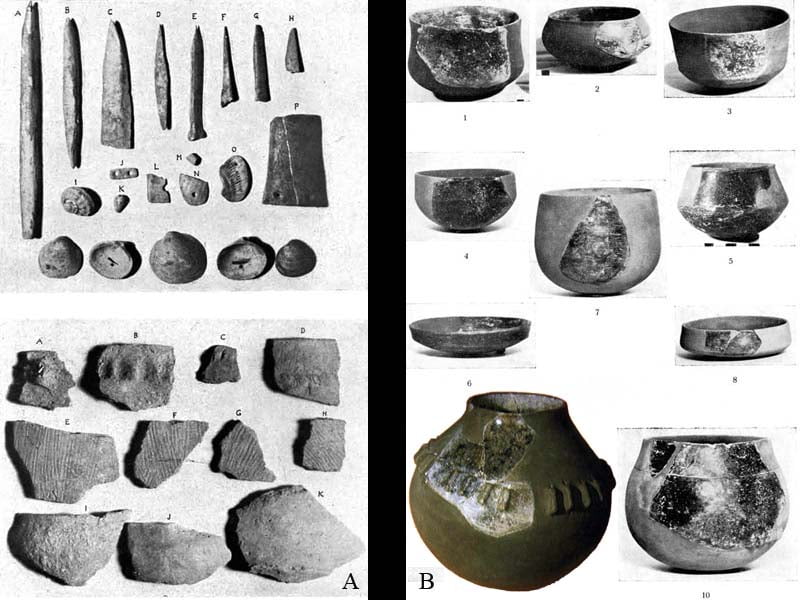
Layers 14 to 16: layers again poor in material, probably because the cave was abandoned in this period, but the first fragments of square-mouthed vases begin to appear to replace those typical of the Lagozza civilization.
Layers 17 to 21: strata dated to the middle Neolithic in which the quantity of archaeological material increases strongly, extraordinarily abundant in 20 and 21, to mark the apogee of the civilization of the cave-dwellers of the Finale area, rich in vases with square mouths, as well as vases with pipes (the characteristic bulbs”), vases with engraved decoration, pintaderas, green stone hatchets, a very beautiful millstone in layer 18, bone tools, worked ornamental shells, some pieces of red and yellow ocher, meander-spiral decorations, terracotta clay idols ( the figurine 15 from layer 18), all elements that suggest strong Balkan influences. Noteworthy in layer 19 is the discovery of pieces of mud plaster, perhaps because huts or other light structures were built inside the cave to make habitation easier. From layer 21 emerged the skeleton of a child of a few months, buried in the earth without equipment and protection, and other tombs.
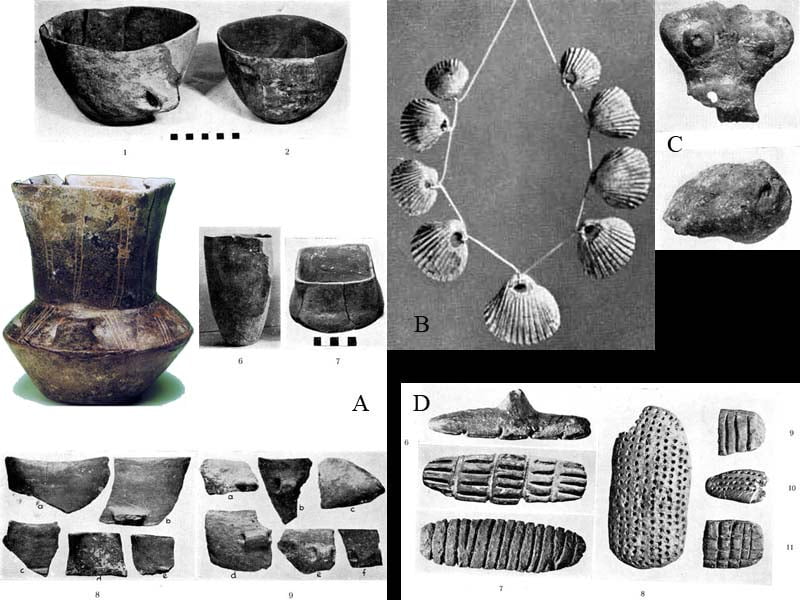
Layers 22 to 24: strata in which, although still abundant, pottery is in sharp decline (especially in strata 23 and 24); the general characteristics are always the same, but vases with a square mouth are increasingly rare, being replaced by those with a quadrilobed mouth. Also from layer 22 pieces of plaster emerged (as in layer 19) and the skeleton of a suckling child, buried in the earth without equipment and protection (as in layer 21). In layers 22 and 23 two pintaderas and a clay head, la figurine no. 3.
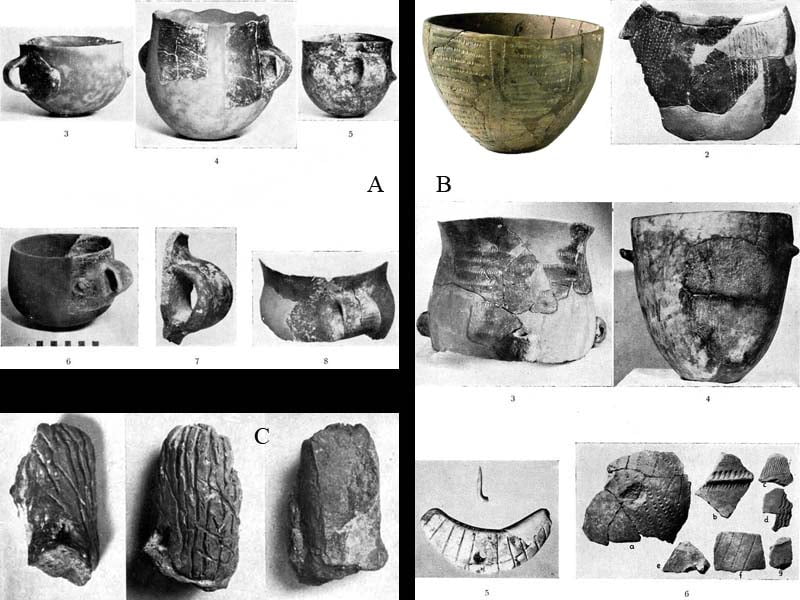
Layers 25 to 27: during the excavation of layer 24, large slabs surfaced to cover four tombs which penetrated into the underlying layers 25, 26 and 27, presenting the same characteristics; in the oldest levels two other tombs without grave goods emerged while, for the rest, the layers were devoid of archaeological material with rare ceramics, mostly undecorated pieces of fine and more glossy ceramics or rougher and less glossy pieces decorated with impressions made in the 'soft clay. Among the imprinted decorations we can distinguish those with indented segments (obtained by sliding a small toothed wheel on soft clay), those with tremolo (obtained by imprinting the edge with a thin wavy sheet), those with dots (imprinting dots generally aligned in regular rows both vertically than horizontally), those with repeated impressions (obtained with the impression of different objects, such as animal teeth, parts of shells, etc.), those with various impressions (similar to the previous one but with impressions so close together as to form continuous or less wide) and those with thin lines (more or less regular incisions). The ceramics found in these layers have many comparisons in southern Italy (Apulia and Sicily), in southern France and Spain, as well as in northern Africa, testifying to the wide-ranging communications that existed at the time. Among the finds also materials that were used for decoration, such as animal teeth (atrophic canines of deer) and shells (gastropods, bivalves, spondylus gaederopus) with traces of processing for the production of elaborate ornaments or other artifacts. The bones of domestic and wild animals were also abundant, all very shredded in order to extract the marrow even from the smallest, as well as the shells of Patella and Trochus. The disappearance of ceramics and domestic animals represented the end of the ancient Neolithic and the beginning of a civilization of the Palaeolithic type associated with a fauna still of the Holocene type which for the first time came to light in Italy.
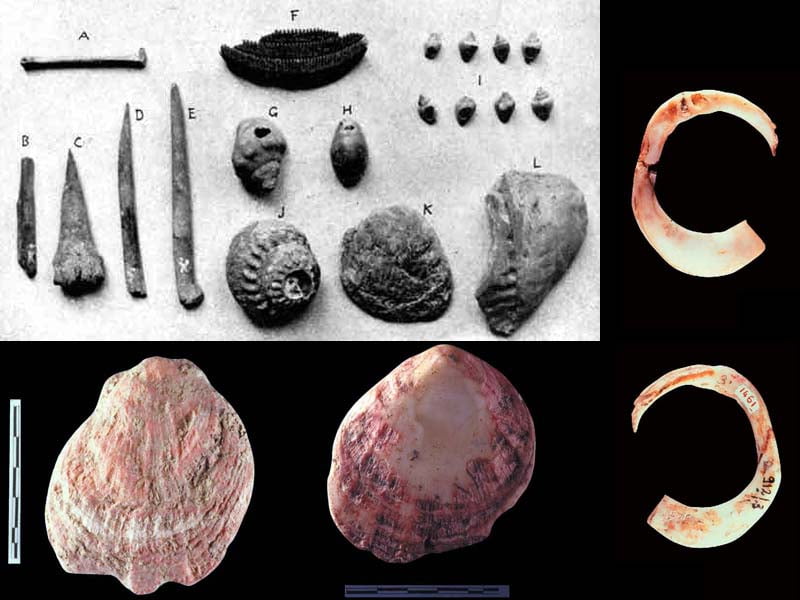
Layer 28: pottery was in sharp decline, almost rare, as were the shells of molluscs, while the bones of very rare birds and the bones of wild fauna increased greatly: these were the layers of the Upper Paleolithic. Worthy of note is the discovery of the tomb of the "warrior with a shell headdress" with its extraordinarily rich equipment, found under a series of superimposed hearths, five of which had yielded an Upper Paleolithic industry of the Gravettian type.
At this point the stratigraphic sequence was interrupted as there were large boulders that were impossible to remove; the work was dangerous due to the lack of compactness of some stony layers and to be able to continue it would have been necessary to widen the surface of the excavation and then deepen the trench below the layers already identified, which was impossible due to the problem of discharging the earth extracted from the excavation.
Many years of detention passed, until 1969, when the Archaeological Superintendence of Liguria decided to resume excavation activities inside the cave, entrusting them to Luigi Cardini who in 1970 investigated the Paleolithic layers. After his premature death in 1971, the direction of the excavations was entrusted to Santo Tinè who from 1972 to 1977 carried out annual campaigns investigating above all the Neolithic strata and reconstructing the attendance of the Arene Candide from the ancient Neolithic to the Eneolithic, also making use of the revision of the finds and bioarchaeological samples of the excavations conducted by Bernabò Brea.
Since 1997 and in particular in the early 2000s Roberto Maggi, archaeologist of the Ligurian Superintendence, has directed new excavations in the Neolithic levels of the north-eastern sector of the cave for the Ministry of Cultural Heritage, while the last excavation campaign took place in 2012 also with the collaboration of Canadian universities.
We come to the present day, other events have affected the cave after the definitive closure of the Ghigliazza quarry which took place in 2007 and the reconversion project for tourism purposes of the area, based on the transformation of industrial volumes into residential buildings, a strong urban planning pressure which fortunately has not never been implemented but prompted the bodies in charge of carrying out activities for the arrangement and enhancement of the cave with the aim of active protection until the site was opened to the public in 2019. More than 150 years after the first investigations, it must be noted that the excavations carried out so far have not never reached the bottom of the cave (which some rightly place it a few meters below the maximum depth reached in the 50s) and therefore it is possible that the site of the Arene Candide contains even more important traces than those that have emerged up to now.
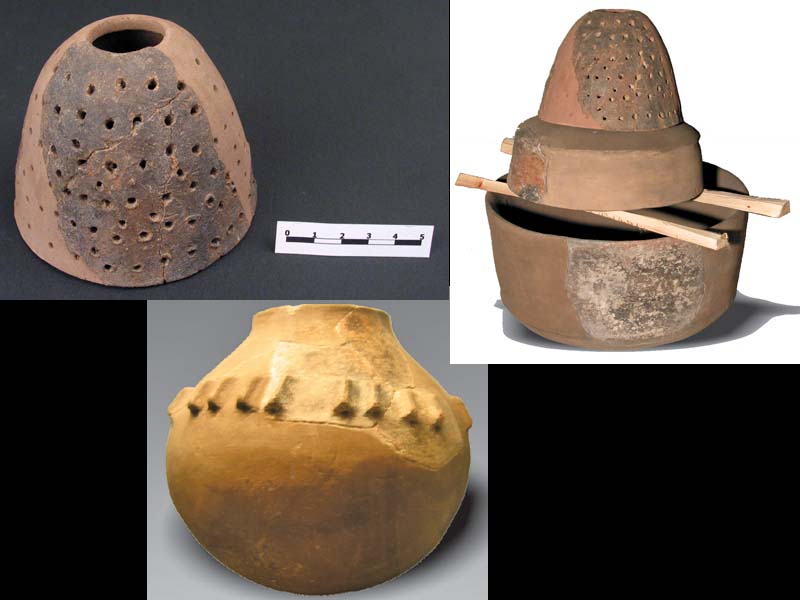
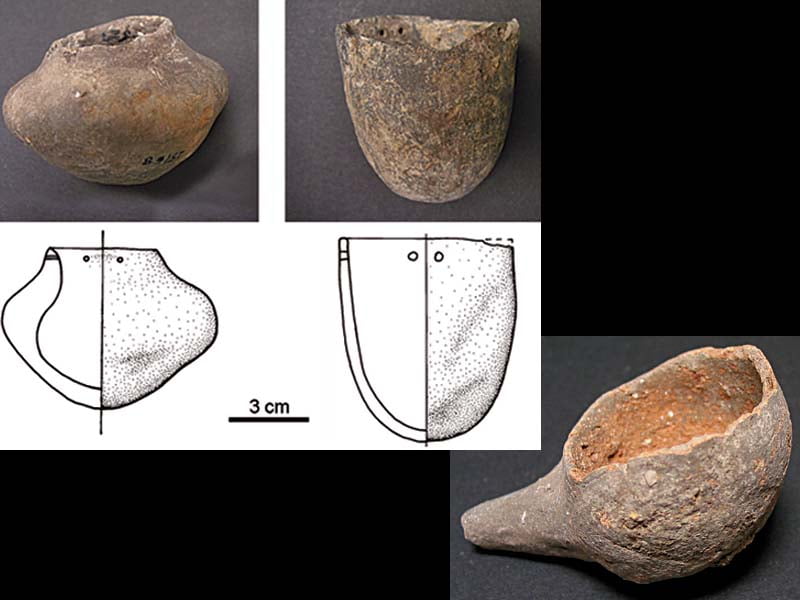
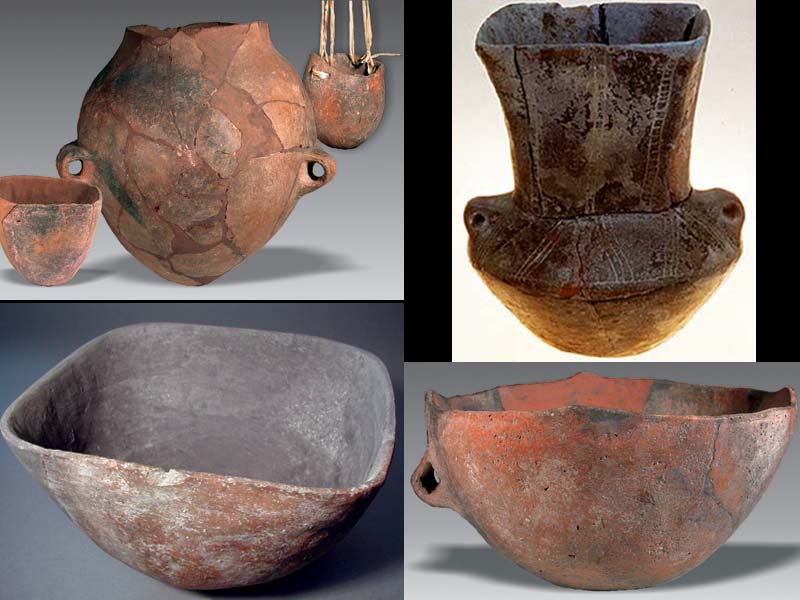
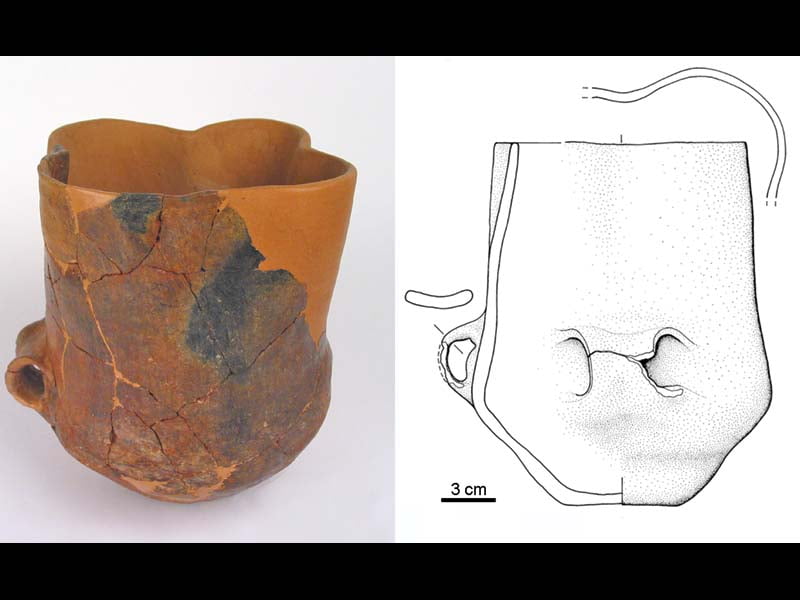
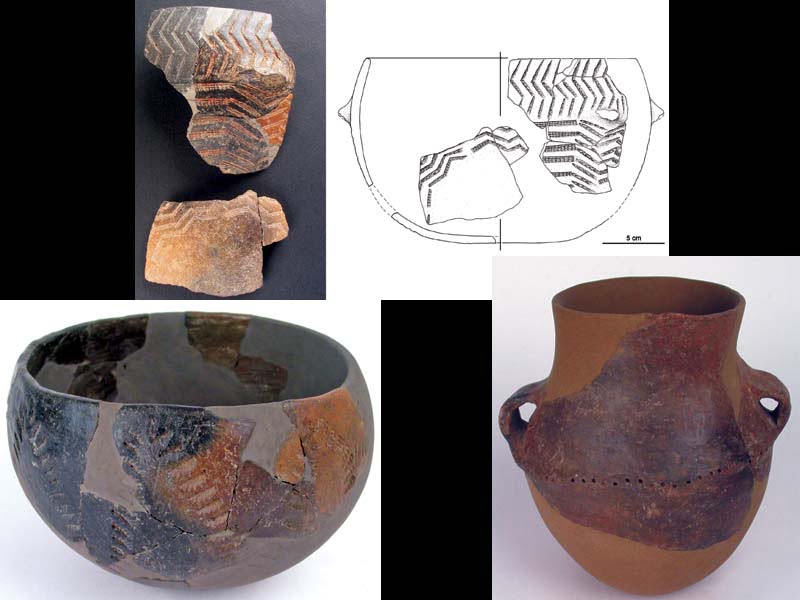
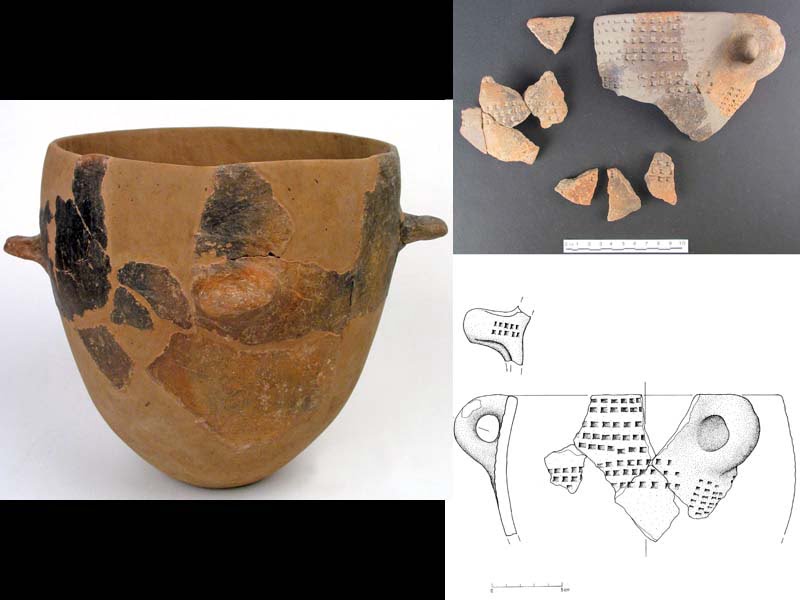
Elvira Visciola with the supervision of Elisa Bianchi, Conservator of the Archaeological Museum of Finale, December 2022
REFERENCES
- Daniele Arrobba and Andrea De Pascale (edited by) – The cave of the Arene Candide. An archive of European prehistory – International Institute of Ligurian Studies – Finale Ligure 2020;
- Arthur Issel – “Prehistoric Liguria” – in Proceedings of the Ligurian Society of Homeland History – volume XL – Genoa 1908;
- Roberto Maggi and Nadia Campana – “Archeology of environmental resources in Liguria: Extraction and subsistence between the XNUMXth and XNUMXrd millennium BC” – in Bulletin of the Musee d'Anthropologie Prehistorique de Monaco – supplement no. 1 – 2008 – pp. 65-74;
- Angiolo Del Lucchese and Elisabetta Starnini – “Updates on the ancient phase of the square-mouthed pot culture in Liguria from an ongoing review of ceramic materials” – in Archeology in Liguria – Volume V – edited by the Ministry of Cultural Heritage and Activities and Tourism – Superintendency of Archeology of Liguria – 2012-2013 – pp. 27-37;
- Luigi Bernabò Brea – The excavations in the Arene Candide cave – Part I: Layers with Ceramics – Volume 1° – Institute of Ligurian Studies – Bordighera 1946;
- Luigi Bernabò Brea – The excavations in the Arene Candide cave (Finale Ligure) – Part I: Layers with Ceramics – Volume 2° – Bordighera 1956;
- Elisabetta Starnini – “Chipped lithic industry” – in The Neolithic in the Cave of Arene Candide (excavations 1972-1977) – edited by Santo Tinè – Bordighera 1999 – pp. 219-236 and 450-471;
- Margherita Mussi, Paul Bahn and Roberto Maggi – “Parietal art discovered at Arene Candide Cave (Liguria, Italy)” – in Antiquity – no. 82 – Cambridge University Press January 2008 – pp. 265-270;
- Margherita Mussi, Paul Bahn, Alessandro De Marco and Roberto Maggi – “New discoveries of Palaeolithic wall art in Italy: the Caverna delle Arene Candide and Grotta Romanelli” – in Alpine prehistory – no. 46 - Trento 2012 - pp. 41-47;
- Vitale Stefano Sparacello, Stefano Rossi, Paul Pettitt, Charlotte Roberts, Julien Riel-Salvatore and Vincenzo Formicola – “New insight on Final Epigravettian funerary behavior at Arene Candide Cave (Western Liguria, Italy)” – in Journal of Anthropological Sciences - volume 96 - 2018 - pp. 161-184;
- Roberto Maggi, Mauro Chiavarini, Viviana Guidetti and Adolfo Pasetti – Cave of the “Arene Candide” (Finale Ligure) Conservation of the residual edges of the sediments left after the excavations – Brixen 1996;
- Paul Pettitt, M. Richards, Roberto Maggi and Vincenzo Formicola – “The Gravettian burial Known as the Prince: new evidence for his age and diet” – in Antiquity – no. 77 – Cambridge University Press June 2011 – pp. 15-19;
- Luigi Cardini – “Schematic anthropomorphic paintings of the Grotta Romanelli and on pebbles of the Mesolithic levels of the cave of the Arene Candide and of the Grotta della Madonna in Praia a Mare” – in Proceedings of the XIV Scientific Meeting in Puglia – Italian Institute of Prehistory and Protohistory – Florence 1972 – pp. 225-235;
- Paolo Biagi and Elisabetta Starnini – “The Culture of Imprinted Ceramics in Western Liguria (Northern Italy): Distribution, chronology and cultural aspects” – in From the neolithic to the edat of the bronze in the western Mediterranean. Estudis en homenatge a Bernat Marti Oliver – Valencia 2016 – pp. 35-49;
- Roberto Maggi – “The graphite ceramic layer of the Arene Candide” – in Graphite pottery in the Neolithic of the central-western Mediterranean – Alpine prehistory volume 13 – Trento 1977 – pp. 205-211;
- Roberto Maggi, Didier Binder, Chiara Panelli, Marzia Gabriele, Mark Pearce, Stefano Rossi, Peter Rowley Conwy – “Liguria: openings and closings of an island between two plains” – in Journal of Prehistoric Sciences – volume LXX – Italian Institute of Prehistory and Protohistory – Florence 2020 – pp. 83-97;
- Maria Borrello and Guido Rossi – “Processing of ornaments in Spondylus gaederopus in the Neolithic of the Caverna delle Arene Candide (Savona, Italy). Preliminary note” – En Alpine prehistory – no. 40 - Trento 2005 - pp. 83-90;
- Marco Serrandimigni – “The pintaderas in the context of the Italian Neolithic: art, symbolism and functionality” – in Alpine prehistory – no. 46 - Trento 2012 - pp. 203-210;
- Andrea De Pascale – “The Neolithic pintaderas in the collections of the Archaeological Museum of Finale” – in Journal of Ligurian Studies – no. LXXVII-LXXIX – 2011-2013 – pp. 203-210;
- Renata Grifoni Cremonesi and Annaluisa Pedrotti – “Neolithic art in Italy: state of research and new acquisitions” – in Alpine prehistory – no. 46 - Trento 2012 - pp. 115-131;
- Mario Giannitrapani – Anthropomorphic Neolithic coroplastic of Italy – Bar International Series 1020 – Oxford 2016;
- Angelo Mosso – The origins of the Mediterranean civilization – Milan 1912;
- Roberto Maggi, Gabriele Martino and Julien Riel Salvatore – “Cavern of the Arene Candide, the excavations 1941-42: the discovery of the Paleolithic” – in Proceedings of the XLVI Scientific Meeting – Italian Institute of Prehistory and Protohistory – Florence 2011 – pp. 431-436;
- Andrea De Pascale – “The first explorations in the bone caves of the Finale area: traces, hypotheses and discoveries by Issel, Perrando, Morelli, Rovereto, Rossi, Amerano…” – in The birth of palethnology in Liguria – Proceedings of the Conference – Bordighera 2008 – pp. 233-248;
- Giovanna Bermond Montanari – “The excavations at Arene Candide (1939-1950): the only basis for prehistoric research after the warto” – in Proceedings of the XXXV Scientific Meeting – first volume – Italian Institute of Prehistory and Protohistory – Florence 2003 – pp. 75-82;
- Santo Tine – “The excavations in the caves of Arene Candide and Pollera” – in Proceedings of the XV Scientific Meeting – Italian Institute of Prehistory and Protohistory – Florence 1972 – pp. 89-93;
- Stefano Rossi, Chiara Panelli, Andrea De Pascale and Roberto Maggi – “Of an ossiferous cave of Finale: evidence of nineteenth-century archeology in the Arene Candide Cave” – in 150 years of Prehistory and Protohistory in Italy – volume 1 – Italian Institute of Prehistory and Protohistory – Florence 2014;
- Margherita Mussi – “Funerary rites in the graves of the Grimaldi Caves and the Arene Candide Caves: a unique setting” – in Natures and Cultures – Colloque de Liege – Liege 1993 – pp. 833-846;
- Vincenzo Formicola – “An infant burial from the Middle Neolithic at Arene Candide” – in Alpine prehistory no. 22 - Trento 1986 - pp. 169-175;
- George Paul - "Age and stature of the Paleolithic youth of Arene Candide” – in Proceedings of the XVI Scientific Meeting – Italian Institute of Prehistory and Protohistory – Florence 1974 – pp. 121-129;
- Del Lucchese Angiolo – The Neolithic burials from Arene Candide cave the Bernabò Brea-Cardini excavations, in Arene Candide: a functional and environmental assessment of the Holocene sequence (excavations Bernabò Brea-Cardini 1940-50) – Memoirs of the Italian Institute of Human Paleontology – Vol. V – 1997.

